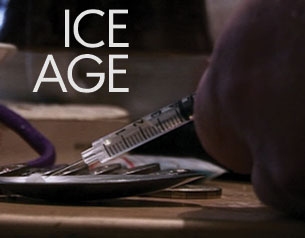Ice Age
It's cheap, highly addictive and ultra-powerful. "Ice", or crystal methamphetamine, is now more popular than heroin. But it does untold damage. A profile of a hidden epidemic.
 It's cheap, highly addictive and ultra-powerful. "Ice", or crystal methamphetamine, is now more popular than heroin. It plays havoc with the minds and the bodies of addicts, filling emergency wards with dangerous, psychotic patients. But little is known about the long term effects of the drug or even how to treat the addiction. And health services are not prepared for the chaos ice has just started to unleash. This week's documentary reports on the hidden epidemic.
It's cheap, highly addictive and ultra-powerful. "Ice", or crystal methamphetamine, is now more popular than heroin. It plays havoc with the minds and the bodies of addicts, filling emergency wards with dangerous, psychotic patients. But little is known about the long term effects of the drug or even how to treat the addiction. And health services are not prepared for the chaos ice has just started to unleash. This week's documentary reports on the hidden epidemic.
"These are the most out of control, most violent human beings I've seen in my whole life and I've been around a long time", despairs Dr Gordian Fulde, Head of the Emergency Unit at St Vincent's hospital. "It makes heroin seem like the good old days." His hospital has seen a five-fold increase in patients admitted with ice psychosis since 2000. They've had to build a special security cell to contain them.
Almost one in four ice users will experience at least one debilitating psychotic episode. "It alters the functions of the brain", explains Professor Iain McGregor. "Heavy users have a reduced brain volume - basically they have brain damage." The ice epidemic has pushed hospitals and mental health units to their limits. Many of their resources have had to be diverted. But doctors are hampered by lack of knowledge about the drug, which appeared on the scene less than ten years ago.
"John" suffers from Ekbom's Syndrome, brought on by chronic addiction. He is covered in scabs and picks obsessively at his skin, desperately trying to pull out the "ice bugs" he believes live inside him. "They live about three layers down and feed on the fat layer", he explains. His delusion is common among ice addicts. His friend, "Lenore", has 23 personalities, each with their own name. She obsessively sorts through rubbish for days on end when she's on ice. It's her way of making order out of her chaos.
John and Leonore are part of a tribe of junkies who roam the inner cities, scoring and shooting up. They stay manically high for up to a week, without food or sleep. Finally, they crash and eat, before the welfare cheque arrives and the cycle starts all over again. "We're the fringe-dwellers," boasts "Mick", whose veins are so wrecked he can barely find a place to inject.
But ice isn't only a cheap drug for hardcore addicts. It's also big on the party circuit, where it's regarded as sociable and affordable. And because it lacks the stigma of heroin, it's used at all levels of society, in the gay community, among students and nightclubbers, shiftworkers and the career minded.
"Jason" used to be a computer engineer earning good money. He started out as a recreational user but now he's an addict determined to kick the habit. "It's going to be hard", he readily acknowledges. As yet, there is no dedicated treatment programme or legal substitute for ice in Australia. Funding for research into withdrawal problems is scarce, meaning the problem looks set to worsen.
This confronting documentary will challenge and unsettle the most hardened of viewers.
FULL SYNOPSIS
